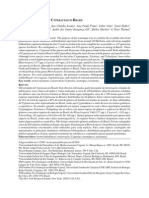Citrus Fruits
Citrus Fruits
Uploaded by
ymonnlopezCopyright:
Available Formats
Citrus Fruits
Citrus Fruits
Uploaded by
ymonnlopezCopyright
Available Formats
Share this document
Did you find this document useful?
Is this content inappropriate?
Copyright:
Available Formats
Citrus Fruits
Citrus Fruits
Uploaded by
ymonnlopezCopyright:
Available Formats
A dozen of mouthwatering tropical fruits that are rich sources of vitamin C and ascorbic acids and will provide
you other health benefits as well. As we all know, vitamins C and ascorbic acid are very important to our health. They help our body fight diseases ; these fruits keep our skin beautiful, our teeth stronger, and many other health benefits. Some of these exotic fruits from the Philippines (and other tropical areas) are now becoming rare, so when you see them in the market dont think twice to buy these fruits because you may never have the chance to see and taste them again. After all, these fruits are very rich in vitamin C and ascorbic acid.
Yantok (Calamus manillensis)
Yantok is a fruit that is not as popular as mangoes and bananas. This exotic fruit is from a vine locally called yantok (a variety of rattan) found in jungle forest areas but it is now actually raised in small plantations for commercial sale. It is one of the sourest fruits in the world. You will not like the acidic taste of yantok the first time you taste it, but one thing is sure, youll crave for its unusual taste later. These fruits are available in the market from August to October.
Guava (Psidium guajava)
Guavas were once very abundant in many places in the Philippines, but due to the rapid growth of the countrys population, their habitats have been cleared for residential purposes that resulted to its scarcity. Guava which is known by the name bayabas in the Philippines is one of the best sources of vitamin C and ascorbic acid. It is richer than calamansi or citrus fruit in vitamin C content.Native to Mexico and Central America, northern South America, parts of the Caribbean and some parts of North Africa, it is now cultivated throughout the tropics.
Bignay (Antidesma bunius)
Sineguelas or Jocote have been naturalized in the Philippines. My grandparents on both sides (paternal and maternal) have sineguelas trees on their backyards. Jocote is native to tropical regions of the Americas. Other common names include Red Mombin, Purple Mombin, Ciruela, or Hog Plum. It is now widely cultivated in tropical regions throughout the world for its edible fruit (it is eaten with salt before they ripen), and is also naturalized in some areas, including the Philippines and Nigeria. Cashew (Anacardium occidentale)
This fruit is called kasoy in the Philippines and they are particularly abundant in the province where I grew up. The edible nuts of kasoy can be roasted and eaten. The cashew is a tree native to northeastern Brazil. Its English name derives from the Portugues name for the fruit of the cashew tree, caju, which in turn derives from the
indigenous Tupi name, acaju. It is now widely grown in tropical climates for its cashew nuts and cashew apples. Santol (Sandoricum koetjape)
Another vitamin rich fruit that I particularly love is santol. I still remember when I was still young, my childhood friend would climb our santol tree and Ill do the catching. Santol is a tropical fruit grown in Southeast Asia. The tree and its fruit has several common names in many languages, including gratawn in Thai, kompem reach in Khmer, tong in Lao, donka in Sinhalese, and wild mangosteen in English and faux mangoustanier in French.
Dalandan or Carambola
We have a dalandan tree in our backyard and I love its sour tasting fruit. Dalandan is a species of tree native to Philippines, Indonesia, India, and Sri Lanka and is popular throughout Southeast Asia, Trinidad, Malaysia and parts of East Asia. It is also grown throughout the tropics. Carambola, its other name, is commercially grown in the US in south Florida and Hawaii for its fruit, known as the starfruit.
Tamarind or Sampalok (Tamarindus indica)
Tamarinds are widely grown in the Philippines for domestic consumption and for commercial purposes. The Tamarind is a tropical tree, native to tropical Africa, including Sudan and parts of the Madagascar. It was introduced into India so long ago that it has often been reported as indigenous there, and it was apparently from India that it reached the Persians and the Arabs who called it tamar hindi (Indian date, from the date-like appearance of the dried pulp), giving rise to both its common and generic names. However, the specific name, indica, also perpetuates the illusion of Indian origin. The fruit was well known to the ancient Egyptians and to the Greeks in the 4th Century B.C.E.
Pomelo (Citrus maxima)
One of the best tasting and most popular varieties of pomelo (locally called suha) is the seedless variety from Davao, Philippines. The pomelo (or Chinese grapefruit, pummelo, pommelo, Lusho Fruit, jabong, boongon, shaddock, limau bali, Balinese Citrus, or suhabaungon is a citrus fruit, usually a pale green to yellow when ripe, larger than a grapefruit, with sweet flesh and thick spongy rind. Soursop (Annona muricata)
Soursop is available all year round but is particularly plenty during rainy season. Annona muricata is locally known in the Philippines as Guyabano. It is known mostly for its edible and vitamin rich fruit that is usually called Soursop due to its slightly acidic taste when ripe. This tree is native to the Caribbean and Central America but are now widely cultivated and in some areas, escaping and living on their own in tropical climates throughout the world. Tamarind, Guyabano and Pomelo are also available in powdered form. Tamarind powder is used for cooking and the last two as juice drinks. Once you have the chance to visit the Philippines and other tropical areas, look for these fruits and youll surely love them. Eat plenty and variety of fruits to have a healthier and longer life. The tree of this sour-tasting fruit usually grows wild along river banks in the Philippines, although plenty are grown as backyard plant. This colorful tropical fruit is locally known as bignay; buni or berunaiin Malaya; wooni or hooni, in Indonesia; ma mao luangin Thailand; kho lien tuin Laos; choi moi in Vietnam; moi-kinand chunkaby the aborigines in Queensland. Among English names are Chinese laurel, currant tree and salamander tree. This fruit is a popular source of wine-making in Baguio City the Summer Capital of the Philippines.
Lanzones (Lansium domesticum)
You might also like
- Steam Cleaner 3000 6000 9000Document4 pagesSteam Cleaner 3000 6000 9000Selim B.DHIABNo ratings yet
- Is Adore SharpDocument9 pagesIs Adore SharpCaron DhojuNo ratings yet
- 023 Sustainability of Green FashionDocument11 pages023 Sustainability of Green FashionVersha PantNo ratings yet
- Types: Guavas AreDocument12 pagesTypes: Guavas AreJesa Rose Tingson100% (1)
- FAO Forage Profile - UgandaDocument17 pagesFAO Forage Profile - UgandaAlbyziaNo ratings yet
- A Remarkable BeetleDocument5 pagesA Remarkable BeetleNGUYÊN PHẠM NGỌC KHÔINo ratings yet
- Interview Guide-1Document17 pagesInterview Guide-1Anonymous hgpfWOOJ0No ratings yet
- Week 7 DLL TleDocument4 pagesWeek 7 DLL TleLourdes LargadoNo ratings yet
- Fruit Chain StoreDocument7 pagesFruit Chain StorebroowodunNo ratings yet
- Assessment Report On Achillea Millefolium HerbaDocument23 pagesAssessment Report On Achillea Millefolium Herbavesna_tasevaNo ratings yet
- Pickles: Preserving Food Anaerobic Fermentation Brine Salt Lactic Acid Marinating Vinegar Acetic Acid Pickle Salty SourDocument4 pagesPickles: Preserving Food Anaerobic Fermentation Brine Salt Lactic Acid Marinating Vinegar Acetic Acid Pickle Salty SourKristy JenacNo ratings yet
- Pickle and Sauekraut Technology 1Document24 pagesPickle and Sauekraut Technology 1Smruthi RaoNo ratings yet
- Competitive Exams: Agroforestry: ExamraceDocument3 pagesCompetitive Exams: Agroforestry: ExamraceVirendra PratapNo ratings yet
- Commercial Egg Production and Processing: Overview of Egg-Type LayersDocument8 pagesCommercial Egg Production and Processing: Overview of Egg-Type Layerscris guzonNo ratings yet
- Tree LucerneDocument25 pagesTree LucerneJustice CJ Malanot100% (1)
- Tagasaste - A Fodder ShrubDocument9 pagesTagasaste - A Fodder ShrubJose CastanedoNo ratings yet
- Ir-029 Fluid and Electrolytes - 4Document9 pagesIr-029 Fluid and Electrolytes - 4Muhammad ShakeelNo ratings yet
- Telecommunication Mast Location and It's Health Implication For Residents in Ogbomoso, NigeriaDocument9 pagesTelecommunication Mast Location and It's Health Implication For Residents in Ogbomoso, Nigeriaabimbola.ipNo ratings yet
- Toxfeet™ - Herbal Detox Foot Soak Pack Rejuvenating Foot SpaDocument2 pagesToxfeet™ - Herbal Detox Foot Soak Pack Rejuvenating Foot SpaThomas RogersNo ratings yet
- Ebola Is Still Here: Voices From Liberia and Sierra Leone On Response and RecoveryDocument16 pagesEbola Is Still Here: Voices From Liberia and Sierra Leone On Response and RecoveryOxfamNo ratings yet
- Final Version of PropagandaDocument41 pagesFinal Version of PropagandaZara IftikharNo ratings yet
- SolarDocument9 pagesSolarashim_scribdNo ratings yet
- Solar Water Heating SystemDocument1 pageSolar Water Heating SystemJiya RobertNo ratings yet
- MaizeDocument1 pageMaizeIsha NisarNo ratings yet
- Basic Foot Care GuideDocument10 pagesBasic Foot Care GuidelaskarNo ratings yet
- History: Tea Processing Is The Method in Which The Leaves From The Tea PlantDocument9 pagesHistory: Tea Processing Is The Method in Which The Leaves From The Tea PlantMonika KshetriNo ratings yet
- Wel Come To My Presentation ON Banana JuiceDocument25 pagesWel Come To My Presentation ON Banana Juicezaber chowdhuryNo ratings yet
- Buying BehaviourDocument83 pagesBuying BehaviourchandamitNo ratings yet
- Optimum Detox Foot Pads, Natural Cleansing Ginger Detox Foot PatchesDocument1 pageOptimum Detox Foot Pads, Natural Cleansing Ginger Detox Foot PatchesBrooke GuntherNo ratings yet
- Leadership Lessons From A TeabagDocument5 pagesLeadership Lessons From A Teabagdood12No ratings yet
- 8 Steps To Choose The Best CRM Software For Your Business in 2020Document3 pages8 Steps To Choose The Best CRM Software For Your Business in 2020360QuadrantsNo ratings yet
- FDC ManifestoDocument70 pagesFDC ManifestoAfrican Centre for Media ExcellenceNo ratings yet
- Retail ConceptDocument61 pagesRetail ConceptManas SarkarNo ratings yet
- Cabbage: Recommended VarietiesDocument8 pagesCabbage: Recommended VarietiesElaineWilliamsNo ratings yet
- Edema (Word)Document8 pagesEdema (Word)MichaelNo ratings yet
- WTD Decision MatrixDocument1 pageWTD Decision Matrixfsh020No ratings yet
- Freehold and Leasehold in BriefDocument9 pagesFreehold and Leasehold in BriefFortune RaymondNo ratings yet
- Integrated Weed Management: Tools and Strategies in A World of Pesticide RestrictionDocument2 pagesIntegrated Weed Management: Tools and Strategies in A World of Pesticide RestrictionDevola SofíazNo ratings yet
- Integrated Pests and Disease Management of AvocadoDocument40 pagesIntegrated Pests and Disease Management of AvocadoAnjani KumarNo ratings yet
- Jackfruit Value Addition ArticleDocument3 pagesJackfruit Value Addition ArticleBaliboola.N.ivanNo ratings yet
- Fenugreek: Trigonella Foenumgraecum LDocument16 pagesFenugreek: Trigonella Foenumgraecum LWaseem KhanNo ratings yet
- Cat WT Weight Company X Company Y Company Z Own Business TimeDocument4 pagesCat WT Weight Company X Company Y Company Z Own Business TimeNakkolopNo ratings yet
- Fruit Juice Concentrate and PowderDocument19 pagesFruit Juice Concentrate and PowderUmesh ThapaNo ratings yet
- Coevolution of Hosts and ParasitesDocument5 pagesCoevolution of Hosts and ParasitesAshok KoyiNo ratings yet
- Rootstock Influence in Fruit CropsDocument4 pagesRootstock Influence in Fruit CropsDr.Eswara Reddy SiddareddyNo ratings yet
- Lecture 1 - Law of Contract-1Document32 pagesLecture 1 - Law of Contract-1skalema34No ratings yet
- Farming SystemDocument62 pagesFarming Systempriya selvarajNo ratings yet
- Ipm in BananaDocument33 pagesIpm in BananaKesi MamaNo ratings yet
- The Feasibility of Unripe MangoDocument8 pagesThe Feasibility of Unripe Mangoheidi gragasinNo ratings yet
- Standardization of Conditions For Fermentation and Maturation of Wine From Amla (Emblica Officinalis Gaertn.)Document9 pagesStandardization of Conditions For Fermentation and Maturation of Wine From Amla (Emblica Officinalis Gaertn.)Leonardo AndrésNo ratings yet
- Pasture Grasses and Legumes For Animals (Description of Different Grasses)Document2 pagesPasture Grasses and Legumes For Animals (Description of Different Grasses)Xz RiveraNo ratings yet
- Luserne Tree InformationDocument26 pagesLuserne Tree Informationpierre van wykNo ratings yet
- Agricultural Broiler ManagementDocument22 pagesAgricultural Broiler ManagementmosesyphiriNo ratings yet
- Major Forest DiseaseDocument31 pagesMajor Forest DiseaseGolam DastogeerNo ratings yet
- Broilers &layers Yaras MaccharlesDocument38 pagesBroilers &layers Yaras MaccharlesNyasha VincentNo ratings yet
- Cost of Cultivation For 1 Acre Maize FarmingDocument2 pagesCost of Cultivation For 1 Acre Maize FarmingSouryadipta Ghosh100% (1)
- Fruit Based BeveragesDocument12 pagesFruit Based BeveragesAsia AmirNo ratings yet
- Propagating Tress and FruitsDocument10 pagesPropagating Tress and FruitsSharmaine H. FlavianoNo ratings yet
- Organic Gardening: 50 natural tips on how to create a garden in your own homeFrom EverandOrganic Gardening: 50 natural tips on how to create a garden in your own homeNo ratings yet
- Sour SopDocument4 pagesSour Sopclint_mystarNo ratings yet
- Video - DINION AN Traffic 4000 IRDocument3 pagesVideo - DINION AN Traffic 4000 IRWilberNo ratings yet
- Edgar Allan Poe - The Black CatDocument11 pagesEdgar Allan Poe - The Black Catmicaconserva100% (2)
- Luapadi Map Output (Lanao Del Norte)Document17 pagesLuapadi Map Output (Lanao Del Norte)John Algen Mendez100% (1)
- Simulink Power System Simulation ToolDocument6 pagesSimulink Power System Simulation ToolBill Cai100% (1)
- DRDODocument8 pagesDRDOPiyush BhattNo ratings yet
- Physical and Motor DevelopmentDocument6 pagesPhysical and Motor DevelopmentJaneth Pinion FloroNo ratings yet
- Infrared Training Brochure - en-USDocument16 pagesInfrared Training Brochure - en-USRaden ArdyNo ratings yet
- Brief Description of Works KUTUSDocument17 pagesBrief Description of Works KUTUSDaniel Sanchez TelloNo ratings yet
- Ridiculously Sensitive Electric Charge DetectorDocument2 pagesRidiculously Sensitive Electric Charge DetectorAdam Rabbani AdnanNo ratings yet
- Practice Exam 1 - Section 1 - Part ADocument21 pagesPractice Exam 1 - Section 1 - Part ASam DeCastroNo ratings yet
- Soft LandscapeDocument45 pagesSoft LandscapeIqram Meon100% (1)
- Diversity of Cyperaceae in BrazilDocument12 pagesDiversity of Cyperaceae in BrazilJúnior SenseyNo ratings yet
- 6890-000 - Montel - MobilexDocument8 pages6890-000 - Montel - MobilexAhmad HamdounNo ratings yet
- Nueva Nosologia Miller 2007Document7 pagesNueva Nosologia Miller 2007catherine ayalaNo ratings yet
- Sop Qa 015Document14 pagesSop Qa 015chalicevitalchemNo ratings yet
- Diet and Growth (Part 1)Document8 pagesDiet and Growth (Part 1)Kenzy HassanNo ratings yet
- CFD Modeling of Heat Transfer, Boiling and Condensation: Nufoam & NumpoolDocument20 pagesCFD Modeling of Heat Transfer, Boiling and Condensation: Nufoam & NumpoolSamarul MeuNo ratings yet
- SAIC-LT-2007 LeaK Testing-Vacuum BoxDocument3 pagesSAIC-LT-2007 LeaK Testing-Vacuum BoxKirubhakarPooranamNo ratings yet
- Addition of 2-3 Digit NumbersDocument28 pagesAddition of 2-3 Digit NumbersJuliah Katrina Yndra FernandezNo ratings yet
- WS4. Lewis Bronsted-Lowry Acids Worksheet (HL)Document4 pagesWS4. Lewis Bronsted-Lowry Acids Worksheet (HL)Yuvraj GuptaNo ratings yet
- Operation Philosophy ZLD-1 R-01Document11 pagesOperation Philosophy ZLD-1 R-01Ayon BoseNo ratings yet
- Photocatalytic of N Doped Tio2 Nanofibers Prepared by ElectrospinningDocument6 pagesPhotocatalytic of N Doped Tio2 Nanofibers Prepared by ElectrospinningPost BozNo ratings yet
- Form 4: Chapter 3 (Quadratic Functions) SPM Practice Fully-Worked SolutionsDocument3 pagesForm 4: Chapter 3 (Quadratic Functions) SPM Practice Fully-Worked SolutionsYusri YunusNo ratings yet
- Moment of Inertia of Equilateral TriangleDocument6 pagesMoment of Inertia of Equilateral TriangleRubirajNo ratings yet
- Prayers AKDDocument241 pagesPrayers AKDmilandeep1990No ratings yet
- Cell Structure & FunctionDocument38 pagesCell Structure & Functiongundogan21100% (1)
- Covid-19 One-Step RT-PCR Kit - CE - Certification of IVD NotificationDocument3 pagesCovid-19 One-Step RT-PCR Kit - CE - Certification of IVD NotificationHarun GanićNo ratings yet
- Isl Assignment 1Document13 pagesIsl Assignment 1Pari WishNo ratings yet
- Doctor of Philosophy (Doctorat) in Numerical AnalysisDocument5 pagesDoctor of Philosophy (Doctorat) in Numerical AnalysisA SNo ratings yet

























































































